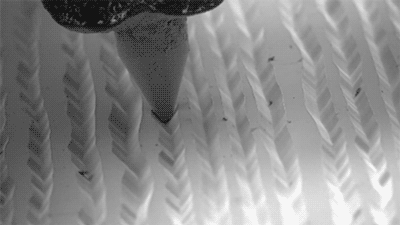Electron microscope video of a needle on a vinyl record.
H O W
like you can tell me all you want how the sound is stored in the grooves but fucking H O W
HOW DOES THAT GET INTO THE NEEDLE
HOW ARE THE VIBRATIONS TURNED INTO MUSIC THAT YOU CAN HEAR???
H O W
The vibrations aren’t “turned into” music, they are music. When vibrations occur inside your inner ear, your brain processes this as sound.
The grooves in a record are an analogy for these vibrations, a method of remembering them so that they can be recreated later on.
Put your hand on a speaker while loud music is playing and you’ll feel the vibrations. Those are exactly the same vibrations happening inside your ear when you hear the music.
But how do you capture that?
Take a surface that vibrates strongly when a sound is played, like the skin of a drumhead for example. Connect that surface to a little tool - when sound causes the surface to vibrate, the tool digs a little bit into some wax, leaving behind a pattern that matches - in proportion - the vibrations of the surface caused by the sound. This is your analogy (hence: analog music).
Now, when there’s no sound playing, you run that little tool back over the pattern. This causes the skin to vibrate again, this time in response to the tool running over the pattern instead of because of an external sound. The vibrations should match, proportionally, the original vibrations of the music.. and thus these new vibrations, if you were to amplify them, would be a recreation or “recording” of the original music.
That’s oversimplified of course and things have changed a lot since the days of wax, but that is very basically how the process of recording music worked at first, and the general idea of how sound gets from a groove in a record into your brain.
(reblogging for Disparition commentary)
Thank you Science side of tumblr
I hugely appreciate people taking to the time explain stuff like this, as it helps put an end to the “wow, science is magic!” trope that’s become far too common.
I actually got to do this in a music class in college. we basically made a rudimentary gramophone using a pin for a needle, connecting it to string and that string piercing a paper horn. Had something spinning the record against the pin and out came the music. Granted it came out extremely distorted and at a low volume, but it really was that simple.
Its wild.
I think the closest I’ve gotten to fully understanding it is when I look at the inner workings of a wind-up music box.

The little metal cylinder is (kinda, sorta, in a much simpler way) like the record.
The placement of the little nubs on it “stores” the music in kinda a similar way to the record grooves
The thingies that pluck and twang on the nubs are a little like the needle
It’s an extremely crude analogy but I can understand it better than the record player, and so by extrapolation I can (kinda, sorta) understand the record player by imagining it as a more complex descendant of the music box.
(I guess for the transformation from inaudible to audible music, you have to imagine that the music box plays so softly you can’t hear it until you put some echoey thing around it to amplify the sound)
